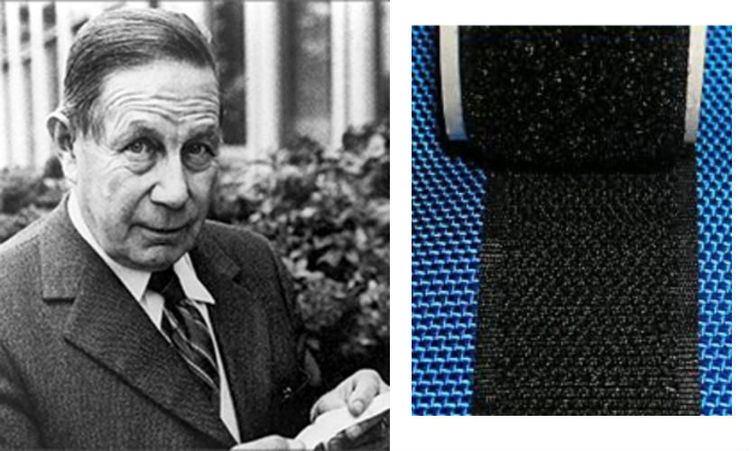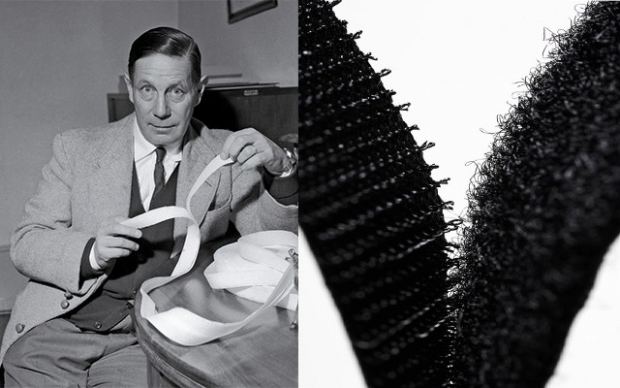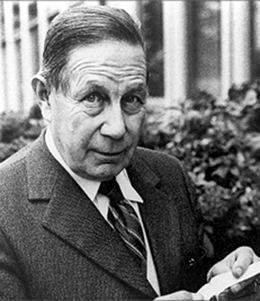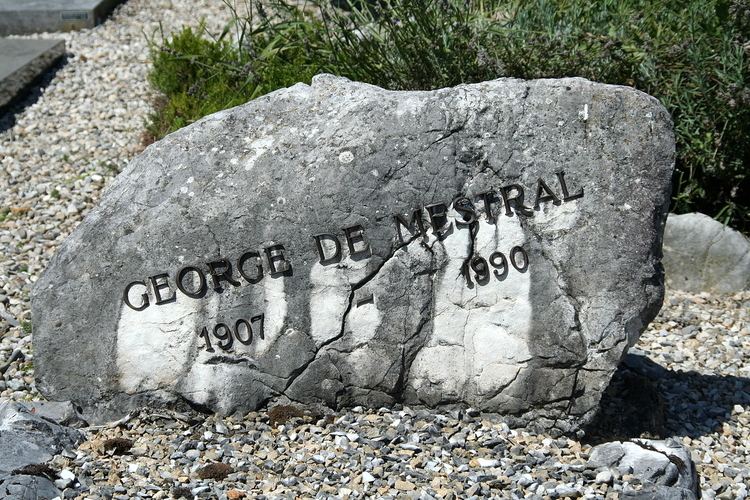Name George Mestral | Role Engineer | |
 | ||
Education Ecole Polytechnique Federale de Lausanne | ||
Lego animation of velcro invented by george de mestral
George de Mestral (June 19, 1907 – February 8, 1990) was a Swiss electrical engineer who invented the hook and loop fastener.
Contents
- Lego animation of velcro invented by george de mestral
- Hindi how Velcro discovered inspirational video in Hindi
- Biography
- Invention of Velcro
- References

(Hindi) how Velcro discovered . inspirational video in Hindi.
Biography

He was born to Albert de Mestral, a civil engineer, and Marthe de Goumoëns in Colombier, near Lausanne, Switzerland. De Mestral designed a toy airplane at age twelve and patented it. He attended the École polytechnique fédérale de Lausanne. After graduation in 1930, he worked in the machine shop of an engineering company. He went for a hike and when he came back he discovered that his dog was covered in burs that had attached themselves to its fur. He then worked on inventing hook and loop fasteners for ten years starting in 1948. In 1955 he successfully patented hook and loop, eventually selling 60 million yards (about 55,000 km) a year through a multimillion-dollar company.

George was married three times: to Jeanne Schnyder in 1932, Monique Panchaud de Bottens in 1949, and Helen Mary Dale. On his father's death in 1966, de Mestral inherited the family home at Colombier, château Saint-Saphorin-sur-Morges.

De Mestral died in Commugny, Switzerland, where he is buried. The municipality posthumously named an avenue, L'avenue George de Mestral, in his honor. He was inducted into the National Inventors Hall of Fame in 1999 for inventing hook and loop fasteners.
Invention of Velcro

De Mestral first conceptualized hook and loop after returning from a hunting trip with his dog in the Alps in 1941. After removing several of the burdock burrs (seeds) that kept sticking to his clothes and his dog's fur, he became curious as to how it worked. He examined them under a microscope, and noted hundreds of "hooks" that caught on anything with a loop, such as clothing, animal fur, or hair. He saw the possibility of binding two materials reversibly in a simple fashion, if he could figure out how to duplicate the hooks and loops.
Originally people refused to take him, and the idea, seriously. He took his idea to Lyon, which was then a center of weaving, where he did manage to gain the help of one weaver, who made two cotton strips that worked. However, the cotton wore out quickly, so de Mestral turned to synthetic fibers. He settled on nylon as being the best synthetic after, through trial and error, he eventually discovered that nylon forms hooks that were perfect for the hook side of the fastener when sewn under hot infrared light. Though he had figured out how to make the hooks, he had yet to figure out a way to mechanize the process, and to make the looped side. Next he found that nylon thread, when woven in loops and heat-treated, retains its shape and is resilient, however the loops had to be cut in just the right spot so that they could be fastened and unfastened many times. On the verge of giving up, a new idea came to him. He bought a pair of shears and trimmed the tops off the loops, thus creating hooks that would match up perfectly with the loops.
Mechanizing the process of the weave of the hooks took eight years, and it took another year to create the loom that trimmed the loops after weaving them. In all, it took ten years to create a mechanized process that worked. He submitted his idea for patent in Switzerland in 1951 and the patent was granted in 1955. De Mestral expected a high demand immediately. Within a few years, he received patents and subsequently opened shop in Germany, Switzerland, the United Kingdom, Sweden, Italy, the Netherlands, Belgium, and Canada. In 1957 he branched out to the textile center of Manchester, New Hampshire in the United States.
De Mestral gave the name Velcro, a portmanteau of the French words velours ("velvet"), and crochet ("hook"), to his invention as well as his company, which continues to manufacture and market the fastening system.
However, hook and loop's integration into the textile industry took time, partly because of its appearance. Hook and loop in the early 1960s looked like it had been made from left-over bits of cheap fabric, an unappealing aspect for clothiers. The first notable use for Velcro® brand hook and loop came in the aerospace industry, where it helped astronauts maneuver in and out of bulky space suits. Eventually, skiers noted the similar advantages of a suit that was easier to get in and out of. Scuba and marine gear followed soon after.
De Mestral unsuccessfully tried to update his patent and it expired in 1978.
